Pediatric Physical Therapy Residency
The mission of Mary Free Bed’s Pediatric Physical Therapy Residency is to restore hope and freedom to pediatric patients and families by developing therapists into expert practitioners. Through our collaborative process focused on clinical reasoning and mentoring, graduates will develop the skills necessary to provide high-value, expert rehabilitation care utilizing a family and patient-centered approach. They will develop advanced knowledge, skills and clinical expertise in pediatric physical therapy in order to become a clinician of choice with a pediatric specialization. Graduates will contribute to and effectively implement evidence-based clinical practice and will share their knowledge and expertise with students, fellow clinicians and the patients/families they serve, while exhibiting high ethical standards and professionalism.
 The Mary Free Bed Rehabilitation Pediatric Physical Therapy Residency is a fully accredited program through the American Board of Physical Therapy Residency and Fellowship Education (ABPTRFE) as a post-professional residency program for physical therapists in pediatric clinical practice.
The Mary Free Bed Rehabilitation Pediatric Physical Therapy Residency is a fully accredited program through the American Board of Physical Therapy Residency and Fellowship Education (ABPTRFE) as a post-professional residency program for physical therapists in pediatric clinical practice.
Learn more
Please explore the categories below for program details.
Check out our Frequently Asked Questions Document here.
Application questions:
Email recruitment@maryfreebed.com.
Program-specific questions:
Email PTpediatricresidency@maryfreebed.com.
General residency/fellowship questions:
Email Therapy.ResFel@maryfreebed.com.
Clinical Curriculum
The curriculum will be based on the most recent Description of Residency Practice (DRP) in Pediatric Physical Therapy from the American Board of Physical Therapy Residency and Fellowship Education.
Primary clinical rotations will be split between our 167-bed rehabilitation hospital and Outpatient Therapy Center. During time in outpatient rehabilitation, residents will work with patients with a variety of diagnoses, including cerebral palsy, torticollis, plagiocephaly, myelomeningocele, developmental delay, autism spectrum disorder, toe walking and limb differences. Inpatient rotations will include working with patients with brain injuries, multiple trauma, spinal cord injuries and those who have undergone major surgical intervention, such as Single Event Multi-Level Surgery (SEMLS) or Selective Dorsal Rhizotomy (SDR).
Mary Free Bed also has established relationships with local organizations to provide clinical learning experiences in the inpatient acute care, school system and early intervention settings. While in each specialty area, the resident will build clinical reasoning skills enhanced through clinical mentoring time with an expert pediatric therapist.
Supplemental professional development activities include clinical observation in multiple specialty clinics (Early Development, Spasticity Management, Center for Limb Differences) and observation of many specialty rehabilitation services, including OrthoSEAT, adaptive technology, Orthotics & Prosthetics + Bionics and the Motion Analysis Laboratory.
Didactics
The didactic curriculum will be based on the most recent Description of Residency Practice (DRP) in Pediatric Physical Therapy from the American Board of Physical Therapy Residency and Fellowship Education. Didactic information will be presented to the resident in a variety of formats — self-guided modules, participation in the APTA Pediatrics Residency and Fellowship Consortium, hands-on practice, discussion with mentors and more — to impart specialty-specific knowledge. Residents will be supported in continuing education opportunities and required to share the information they learned with the team.
Dedicated time also will be spent engaging in a scientific inquiry project with a research mentor and collaborator.
Residents will have the opportunity to gain teaching experience working with physical therapy students. They will participate in Grand Valley State University’s Department of Physical Therapy in the pediatric lab setting and will collaborate with a mentor in serving as a part-time clinical instructor in the outpatient setting.
Faculty
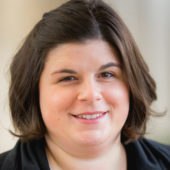 Kate Rustem, PT, DPT, C/NDT
Kate Rustem, PT, DPT, C/NDT
Pediatric PT Residency coordinator, Outpatient Pediatric Therapy Team mentor
• Board-Certified Clinical Specialist in Pediatric Physical Therapy
• Certified in Neurodevelopmental Treatment
• Focus areas: Motion analysis, Advanced Management of Pediatric Spasticity (AMPS), neurodevelopmental treatment
• DPT, Grand Valley State University; BS Physiology, Michigan State University
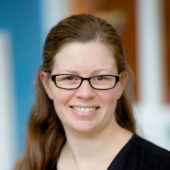 Jennie Taylor, PT, DPT, CBIS
Jennie Taylor, PT, DPT, CBIS
Inpatient Pediatric Therapy Team mentor
• Certified Brain Injury Specialist
• DPT, BS Health Science, Grand Valley State University
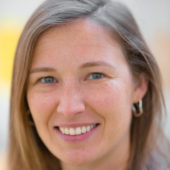 Cara Hudson, PT, MSPT, CBIS
Cara Hudson, PT, MSPT, CBIS
Inpatient Pediatric Therapy Team mentor
• Certified Brain Injury Specialist
• Focus areas: Brain injury, SEMLS/SDR
• MS PT, Grand Valley State University
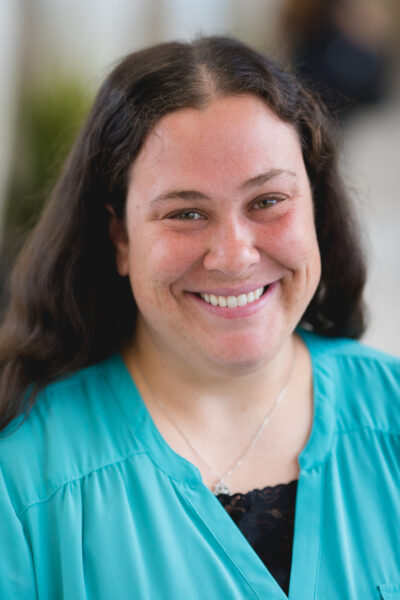 Ashleigh Holden, PT, DPT
Ashleigh Holden, PT, DPT
Acute Care and Outpatient Pediatric Therapy Team mentor
• Focus areas: NICU, early development, post-concussion, aquatic therapy
• DPT Andrews University; BS in Chemistry, Kalamazoo College
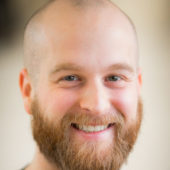 Micah Huegel, PT, DPT, C/NDT
Micah Huegel, PT, DPT, C/NDT
Outpatient Pediatric Therapy Team mentor
• Focus areas: Early Development Program, neurodevelopmental treatment
• DPT Grand Valley State University; BS Athletic Training Saginaw Valley State University
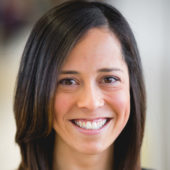
Andrea Dennis, PT, DPT, C/NDT
Outpatient Pediatric Program Manager
• Certified in Neurodevelopmental Treatment
• Certified in the Schroth Method through the Barcelona Scoliosis Physical Therapy School
• Focus areas: Schroth Method treatment, neurodevelopmental treatment
• DPT, BS, Grand Valley State University
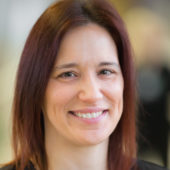 Lura Naessens, PT, MSPT
Lura Naessens, PT, MSPT
Outpatient Pediatric Therapy Team mentor
• Focus areas: Equipment clinic, manual therapy, post-concussion
• MSPT, BS Therapeutic Recreation, Central Michigan University
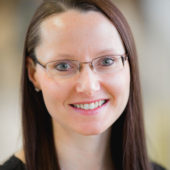 Janae Thaler, PT, DPT
Janae Thaler, PT, DPT
Outpatient Pediatric Therapy Team mentor
• Certified Brain Injury Specialist
• Focus area: Pediatric Day Rehab Program
• DPT, Central Michigan University; BS in Exercise and Health Science, Alma College
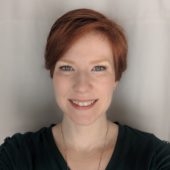 Ellen Hildebrand, PT, DPT
Ellen Hildebrand, PT, DPT
• Early Intervention mentor, Early On at Kent ISD
• DPT, BS Biomedical Sciences, Grand Valley State University
Job Details
The resident will have full-time status as a Mary Free Bed employee, which includes full-time benefits. The resident also will be appointed part-time faculty at Grand Valley State University, which includes access to all university resources.
Fees: $400 for curriculum.
Eligibility
The applicant must be a physical therapist or in his or her final year of an accredited physical therapy program. Applicants must have obtained State of Michigan licensure prior to beginning the residency in mid-September.
Want to apply?
Applications will open in October 2025 for the 2026-2027 Residency year.
Interviews will be held in February. Please submit your application through the RF-PTCAS system. Click here to begin the process.
For program-specific questions, email PTpediatricresidency@maryfreebed.com.
Download the Mary Free Bed Rehabilitation Pediatric Residency Program Financial Fact Sheet.
Outcomes
Programmatic Goals
Goal 1: To graduate residents with post-professional experiential learning in pediatric physical therapy who have a comprehensive understanding of pediatric PT practice and provide high-quality care to patients/students and families.
Goal 2: To develop advanced trained clinicians who will provide high quality, evidence-based clinical services as part of an interdisciplinary team.
Goal 3: To empower physical therapists to practice ethical clinical decision-making and demonstrate professionalism and virtuous behavior.
Goal 4: To develop physical therapists into practitioners who value and contribute to the profession of physical therapy and the healthcare community through evidence-based practice, teaching and advancing the body of knowledge in pediatric physical therapy.
Goal 5: To maintain a high caliber residency program and ABPTRFE accreditation as a pediatric residency program.
Goal 6: To develop clinician expertise in pediatric physical therapy practice and prepare participants to pursue specialist certification through the American Physical Therapy Association.
These goals are assessed using 20 key indicators.
Program Outcomes
• Display a comprehensive understanding of the foundational knowledge for pediatric clinical practice consistent with the knowledge areas and client/patient management areas of the Description of Residency Practice – Pediatrics.
• Become an advanced trained clinician who will provide high quality evidence-based clinical services to the community, incorporating appropriate best practice strategies, new techniques and applied knowledge into pediatric physical therapy practice across all practice settings while serving as a part of an interdisciplinary team.
• Exhibit high standards of ethical clinical decision making, virtuous behavior and professionalism.
• Exemplify dedication to evidence-based practice and the advancement of the physical therapy profession through clinical teaching and scientific inquiry.
• Meet qualifications/eligibility for and be prepared to sit for ABPTS Pediatric Clinical Specialist board examination within 2 years of completion of the residency program.
These outcomes are assessed using 27 key indicators.
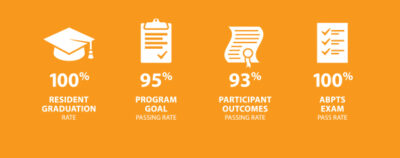
Research
Each year, the resident presents his or her findings at Mary Free Bed Rehabilitation Hospital’s Interdisciplinary Grand Rounds. Listed below are the citations for the residents’ additional presentations and links to the published works.
-
-
- Huegel M, Kenyon L. Application of the clinical practice guideline for congenital muscular torticollis: a case report. Pediatr Phys Ther. 2019;31:E1-E5. doi: 10.1097/PEP.0000000000000569.
- Huegel M, Kenyon L. Commentary on “pediatric physical therapists’ use of the congenital muscular torticollis clinical practice guidelines: a qualitative implementation study”. Pediatr Phys Ther. 2019:337. doi: 10.1097/PEP.0000000000000640.
- Visser A, Westman M, Otieno S, Kenyon L. A home-based body weight-supported treadmill program for children with cerebral palsy: a pilot study. Pediatr Phys Ther. 2017;29:223-229. doi: 10.1097/PEP.0000000000000406.
- Kenyon L, Westman M, Hefferan A, McCrary P, Baker B. A home-based body weight supported treadmill training program for children with cerebral palsy: a case series. Physiotherapy Theory and Practice. 2017;33(7):576-585. doi: 10.1080/09593985.2017.1325956.
- Fisher-Pipher S, Kenyon L. Management of bilateral complex regional pain syndrome in a pediatric patient. Pediatr Phys Ther. 2015;27:443-451. doi:10.1097/PEP.0000000000000175.
- Fisher-Pipher S, Kenyon L, Westman M. Improving balance, mobility, and dual-task performance in an adolescent with cerebral palsy: a case report. Physiotherapy Theory and Practice. 2017;33(7):586-595. doi:10.1080/09593985.2017.1323359.
- Huegel M, Otieno S, Kenyon L. Validity of the WST and the WST-Q in children with spina bifida: a pilot project. Disabil Rehabil Assist Technol. 2019;14(7):744
-


